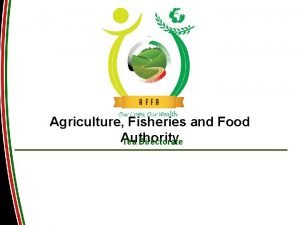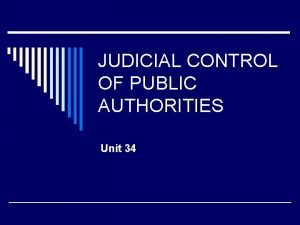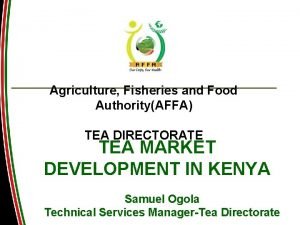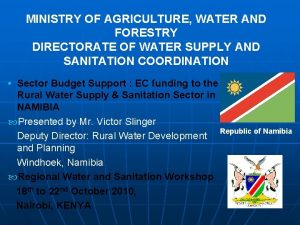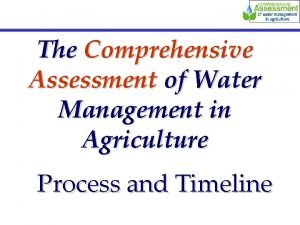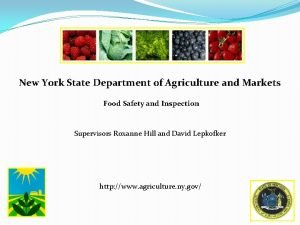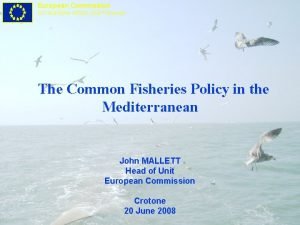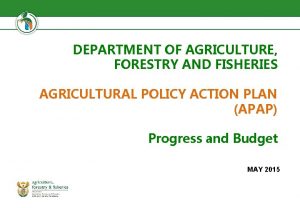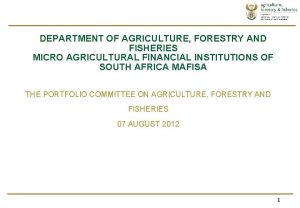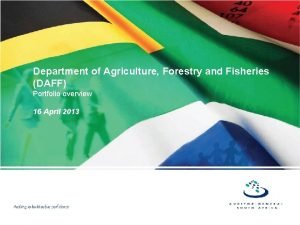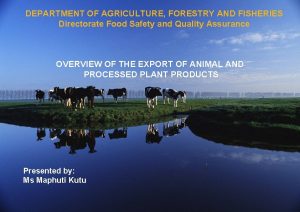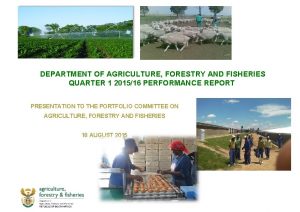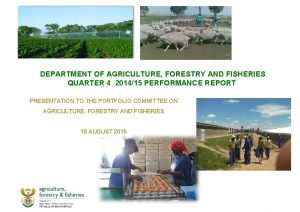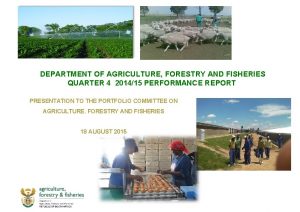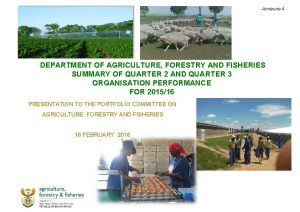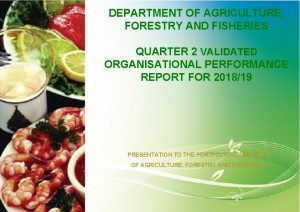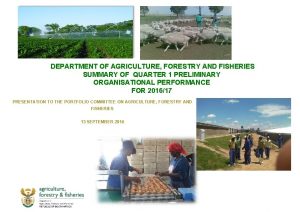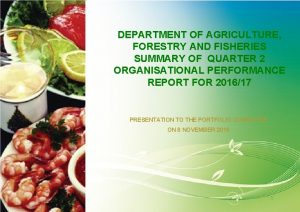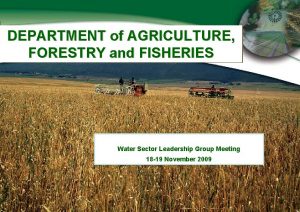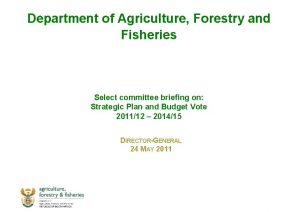DEPARTMENT OF AGRICULTURE FORESTRY AND FISHERIES COMPREHENSIVE AGRICULTURAL














- Slides: 14

DEPARTMENT OF AGRICULTURE, FORESTRY AND FISHERIES COMPREHENSIVE AGRICULTURAL SUPPORT PROGRAMME IMPACT EVALUATION 20 OCTOBER 2015

BACKGROUND • An impact evaluation of the Comprehensive Agricultural Support Programme (CASP) was commissioned by the Department of Performance Monitoring and Evaluation (DPME) in partnership with the Department of Agriculture, Forestry and Fisheries (DAFF). • This evaluation was conducted during the 2013/14 period • The final report which was made available to DPME by the service provider on 30 March 2015 has not yet been formally presented to DAFF by DPME 2

PURPOSE OF THE EVALUATION • The main purpose of the evaluation was to determine whether CASP is achieving its policy goals. In particular, the evaluation was required to assess the impact of the Programme on: » livelihoods, » market access, » Commercialisation, and » agricultural production. 3

KEY POLICY FINDINGS • CASP has made progress towards achieving some of its intended objectives (e. g. enhancing access to support services, increasing agricultural production, increasing income for beneficiaries, etc. ), but insufficient progress has been made in promoting commercialisation, market access, employment and achieving food security. » Only 33% of all farms included in the evaluation are considered to be commercial. The majority of CASP farmers do not find it easier to access formal markets than prior to CASP. » CASP has made a positive contribution to the food security situation of about half of its beneficiaries. » Employment has increased after CASP participation on most projects: the average number of full-time employees per project before and after CASP was 11 and 16, respectively, while the average number of part-time workers rose from 6 to 14. 4

KEY POLICY FINDINGS … (2) • CASP is reaching most of the target groups but relatively few youth and disabled persons are involved in the programme. » These sections of the target population constitute only 14% and 3% of all participants in CASP, respectively. • Agricultural production, both crop and livestock, has increased after CASP. » However, the increase occurred only in certain products and parts of the country. » Average production per farm for major crops such as maize, wheat and sugarcane » increased in less than half the number of provinces covered in the evaluation. » Significant increases were largely in vegetable and livestock production. 5

KEY POLICY FINDINGS … (3) • Although CASP has contributed to capacity building through skills transfer, the programme has made little contribution to building the capacity of the projects to be self-reliant. » Capacity building has not been adequate as some of the projects are still dependent on support from CASP despite many years of being assisted. • Access for farmers to support services, such as agricultural information, inputs, extension advice and training has increased after CASP. » However, some beneficiaries find the support inadequate, expenditure-led and not driven by the real needs of the farmers. 6

KEY POLICY FINDINGS … (4) • There is limited coordination of CASP within DAFF and the provincial departments of agriculture and the programme is not aligned to other government programmes (e. g. those of Department of Rural Development and Land Reform, Department of Water and Sanitation, etc. ) » Within DAFF, there is lack of buy-in from key directorates. • The scope and coverage of CASP are too wide, resulting in resources being thinly spread. » This limits the effectiveness of the programme in achieving its intended objectives. 7

RECOMMENDATIONS Preface: • The most effective and efficient way to support farmers in South Africa is to overhaul and redesign all farmer support programmes and do away with existing silos of farmer support. » This should entail the establishment of a single programme of farmer support to replace the numerous programmes which currently exist. 8

RECOMMENDATIONS … (2) 1. CASP should be institutionalised or mainstreamed within DAFF to ensure proper coordination and participation of directorates that should be playing key roles in the implementation of the programme. 2. The current CASP funding approach of a wholesale grant should be discontinued. The approach does not only encourage a dependency syndrome but also promotes an entitlementality and limited commitment on the part of beneficiaries. 9

RECOMMENDATIONS … (3) 3. 4. 5. 6. The scope and coverage of CASP should be reduced to increase its effectiveness, with special emphasis on the commercialisation of small-scale agriculture. DAFF and provincial departments of agriculture should increase their efforts to promote market access and commercialisation. CASP support should be extended to role players other than farmers within the agricultural value chain (e. g. local agro-processing). DAFF should endeavour to improve the involvement of youth, women and people with disabilities in CASPsupported projects, particularly in project management. 10

IMPLEMENTATION PLAN • The process to develop the implementation plan is led by DPME and clearly outlined in the DPME Evaluation framework. This becomes an inclusive process that involves provinces and key stakeholders. » Submit evaluation report to DAFF » Receive management response, within 30 days » Plan and conduct a workshop to develop the implementation plan » Present the approved implementation plan and Evaluation report to Cabinet » Monitor implementation of the plan 11

WHAT HAS DAFF DONE IN ANTICIPATION? • Align the application of CASP and Ilima LETSEMA to agriculture as a primary conduit for economic growth or the Revitalisation of the Agriculture and Agri. Processing Value Chain, and APAP as the programmatic response • Developed the Norms and Standard for Comprehensive Producer support in South Africa to provide guiding principles and coordinating mechanisms for the following: o Ensure quality in the provision of services and supports o Close the gaps in the provision of services and supports o Eliminate duplication o Draw in effective participation of the private sector o Provide a coordination framework for Comprehensive Producer Support and Service Provision o Create platform to deliver on the NDP 12

WHAT HAS DAFF DONE IN ANTICIPATION? • Started the process for the development of an Integrated Finance Model • Took a decision to develop a Policy on Comprehensive Producer Support in South Africa • Took a decision to institutionalise the Chief Directorate for Conditional Grant Management within DAFF • Strengthened monitoring and evaluation of projects supported by the conditional grants • Initiate a process with National Treasury to review the Scheduling or the conditions of the conditional grants 13

Thank you
 Oviposition
Oviposition Tea directorate
Tea directorate Ministry of food agriculture and fisheries denmark
Ministry of food agriculture and fisheries denmark Rules of natural justice
Rules of natural justice 399
399 Ministry of agriculture, water and forestry directorates
Ministry of agriculture, water and forestry directorates Mendel university fees
Mendel university fees Eturgu
Eturgu Comprehensive assessment of water management in agriculture
Comprehensive assessment of water management in agriculture Fl dept of agriculture
Fl dept of agriculture Virginia department of agriculture food safety
Virginia department of agriculture food safety Article 20-c food processing license
Article 20-c food processing license Split institute of oceanography and fisheries
Split institute of oceanography and fisheries Institute of oceanography and fisheries
Institute of oceanography and fisheries Dg fisheries
Dg fisheries

